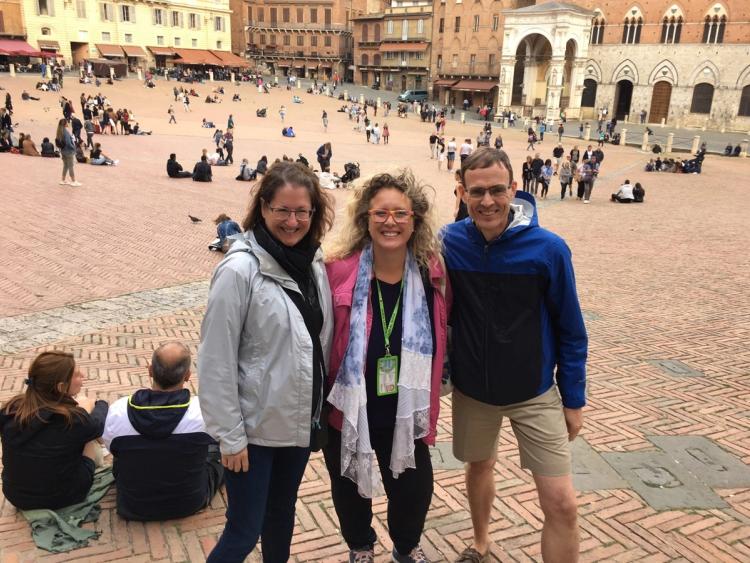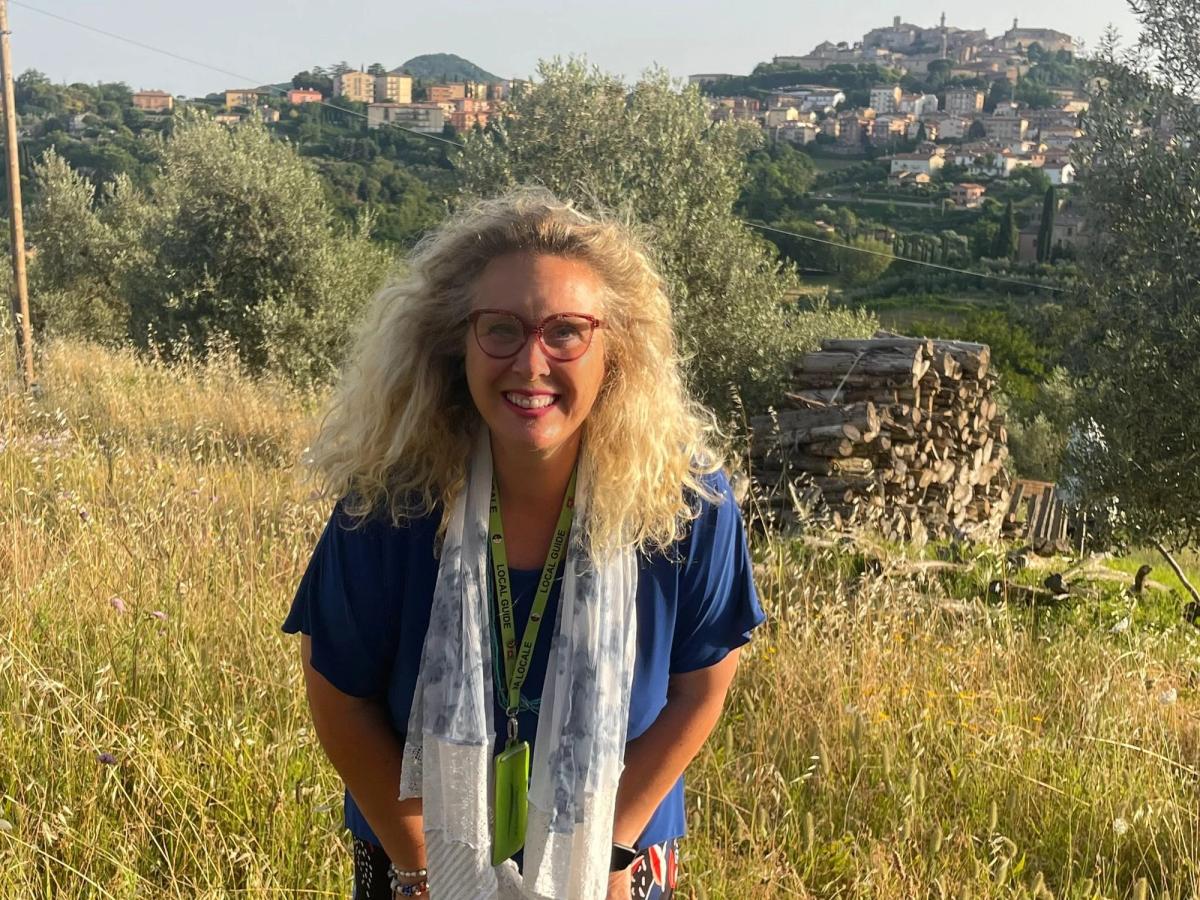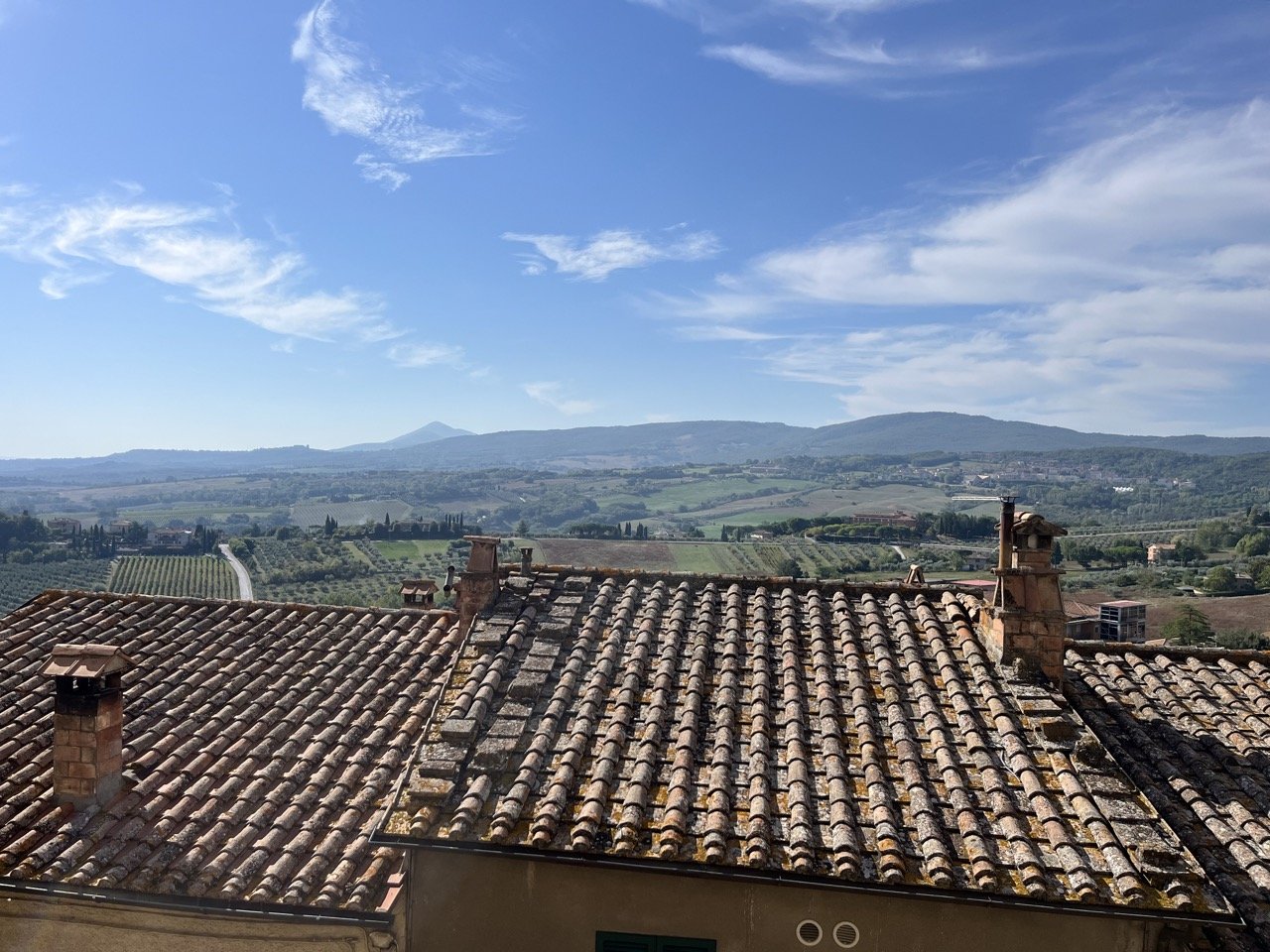Guide to Wine and Wineries in the Val d’Orcia
The Val d’Orica, a swath of rolling hills in Tuscany just south of Siena, can lay claim to two superlatives. First, the landscape of farms and vineyards topped by picturesque little towns is certainly one of the most beautiful places in all of Italy, and that’s saying a lot.
The second is being home to some of Italy’s very best wineries. The region produces two of the best wines in the world; Brunello di Montalcino and Vino Nobile di Montepulciano.
Vineyards that yield these and other fine ones carpet the hills, and wine lovers who make the trip out from Florence or Siena, both a fairly easy drive away, will find themselves with an embarrassment of riches as they make their way along cypress-shaded roads from one vineyard to the next.
Table of Contents
Plan your itinerary with local help
If you could use some help planning your Tuscany itinerary, schedule a Tuscany travel consultation with Serena, our Montepulciano-based Local Expert!
These are one-hour Zoom calls where you’ll get to chat with Serena about the trip you’re planning and she’ll share her tips and advice, answer your travel questions, and help you perfect your itinerary.
Wines produced in the Val d’Orcia
The Val d’Orcia produces some of Italy’s most distinguished wines, the most noted of which are Brunello di Montalcino and Vino Nobile di Montepulciano, made from Sangiovese grapes grown around their two namesake cities.
You will also find Rosso di Montalcino and Rosso di Montepulciano, both of which use the same type of grapes as their “big brothers”, and are grown in the same areas, but with less stringent requirements as to their quality and production. As such, they command a lower price.
The region also grows wines under the Orcia DOC designation whose composition is a mix of Sangiovese and Trebbiano as well as other grapes.
As you make the rounds of wineries and shops you will surely come across the term “Riserva,” as in Brunello di Montalcino Riserva. This means the wine has been aged longer than usual, both in barrels and in the bottle.
Although wine has been grown in this region for centuries, it was not until relatively recently that bold reds became the Val d’Orcia’s calling card. Throughout much of the Middle Ages, most wine production actually focused on a sort of Moscatello, a sweet white wine that was mostly shipped off for sale in Rome.
Brunello di Montalcino
The Biondi-Santi family began producing Brunello in vineyards outside Montalcino in the 19th century, but the wine did not enter production of any considerable size until the 1960s.
In 1980 Brunello di Montalcino became the first wine to receive a designation of Denominazione di Origine Controllata e Garantita (DOCG), the highest classification of Italian wines that regulates such matters as where the grapes are grown, how they are processed, and how long the wine is aged.
In the case of Brunello, the wine must be made from 100 percent Sangiovese grapes from vines that can only be grown at altitudes of less than 600 meters (1,960 feet) to ensure the grapes achieve maximum ripeness and flavor before they are harvested. It must then be aged for at least four years, part of that time in oak barrels.
The name roughly translates as “little dark one,” and the wine is deep red in color, full-bodied, and has a slight taste of wild berries.
Rosso di Montalcino
Rosso di Montalcino is “fresher” than its more distinguished sibling, usually made from younger vines. These wines have a slightly less stringent Denominazione di Origine Controllata (DOC) classification, and as such must also be made from 100 percent Sangiovese grapes grown within a certain radius of Montalcino, and then aged for a minimum of six months. They are also full bodied and taste slightly of wild berries.
Because these wines are not regarded as highly, especially by importers outside of Italy, they often present an excellent price-quality ration.
Vino Nobile di Montepulciano
Montepulciano reds have been noted since the 14th century, and became increasingly popular after World War One. Vino Nobile di Montepulciano wines have a DOCG designation and are made from a minimum of 70 percent Sangiovese grapes blended with Canaiolo Nero grapes and sometimes other varieties.
According to DOCG regulations they are aged for two years, at least one year in oak.
Rosso di Montepulciano
Less prestigious but still highly regarded are the Rosso di Montepulciano DOCs. In a relationship similar to that of Brunello di Montalcino and Rosso di Montalcino, Rosso di Montepulciano is fresher than its Nobile sibling, grapes are from younger vines, and the wine is aged for six months instead of 24 months.
Like Vino Nobile, Rosso is made from 70 percent Sangiovese grapes that also are usually blended with Canaiolo Nero grapes. Both are ruby red and taste slightly of red berries.
Though Montepulciano is not officially in the Val d’Orcia, the handsome town sits right on the edge of the region and you’ll come upon Montepulciano vineyards when driving around the countryside.
Orcia DOC
The Val d’Orcia has its own wine designation, the Orcia DOC. These wines are made primarily from Sangiovese grapes, and as designated by the Consorzio del Vino Orcia, include the following different variations, all produced in vineyards around Pienza, Montalcino, San Querico d’Orcia, Radicofani, and other towns in the region:
Orcia, made from 60 percent Sangiovese grapes and released into the market in the March following the harvest;
Orcia Riserva, aged a minimum of 24 months, at least 12 in oak barrels
Orcia Sangiovese, made from 90 percent Sangiovese grapes
Orcia Sangiovese Riserva, aged for 30 months, at least 24 in oak barrels
Orcia Rosato, made from 40 percent Sangiovese and a blend of other grapes not to exceed 10 percent white grapes
Orcia white, from 50 percent Trebbiano grapes and a blend of other white grapes
Orcia Vin Santo, made from a blend of Trebbiano, Malvasia, and other grapes
IGTs
Some other wines grown in the Val d’Orcia are designated as Toscana IGTs, for Indicazione Geografica Tipica, which places few restrictions outside the Tuscan geographic designation and some levels of quality.
They include reds, whites, and roses, and many Toscana IGTs produced in the Val d’Orcia are reds made from Sangiovese grapes. Since makers of these IGTs aren’t hemmed in by the stricter DOC and DOCG regulations they tend to experiment, with some pleasing results.
It’s enlightening to talk to them about that they are doing with their wines and you’re likely to make some new discoveries.
*For more information on wine growing in Tuscany, the myriad varietals of wine, and in-depth explanations of the many apelations and designations, see our guide to wine in Tuscany.
When to visit vineyards in the Val d’Orcia
Most wineries in the region are open to visitors year round. Choosing a time to visit them is one of those decisions for which there’s not really a bad choice, though good weather, more or less assured from May through October, is a real asset when touring these lovely landscapes.
Late spring, especially early June, is an especially good time to visit. The weather is likely to be good, temperatures are mild, and the landscape is glorious: vineyards and forests have come back to life in a burst of greenery and the rolling hills are carpeted in poppies and golden wheat.
Summers can be hot, in the mid 80s by July, but the landscapes are still beautiful and golden, and outside of wine touring there’s a lot to do outside in this region with great options for cycling, hiking, and just being out of doors enjoying the countryside.
In Fall, you’ll have the chance to see the harvest and witness the changing landscape, but timing is everything. Harvest time varies from year to year, between September and October, so you might miss the flurry of grape picking on an October visit.
Even so, the raked fields and golden and russet hues are a beautiful sight in the autumn light, and temperatures are mild with cool nights. Autumn is fairly short lived, though, and by November it can be chilly and wet.
Winter, not surprisingly, is the least appealing time to tour the wineries. Tasting rooms are open, usually with shortened hours, but a chill rain often falls, landscapes are gray, and roads are muddy. You probably won’t want to walk around the vineyards, and those usually stunning Val d’Orcia landscapes do not appear at their golden and green best.
On the plus side, wineries have far fewer visitors, so staff are less hurried and have more time to spend with guests and explain the wines in depth.


Wine harvest in the Val d’Orcia
Grapes are harvested in September or early October. Dates vary from year to year, and even from vineyard to vineyard. It all comes down to what the weather has been like throughout the growing season and how much rain has fallen. The deciding factor is the proportion of sugar and acid in the grapes, as these affect fermentation.
The harvest, vendemmia, is fairly short, often just a few days. Scores or workers move through the vineyards, cutting the bunches of grapes by hand and placing them into crates that are taken to the cellars for processing. It’s not likely you’ll see much of this activity up-close, as wine-picking is serious business and wineries only allow registered and insured workers into the vineyards for the harvest.
That said, a few wineries host wine picking-and-tasting events, just before or after the main harvest. Many agriturismi - accommodations on working farms - have vineyards and if your stay coincides with the harvest you’ll probably be given a chance to pick some grapes with the proprietors or at least be invited to witness the activity.
The Val d’Orcia’s big wine celebration is the last weekend in April, when San Quirico d’Orcia hosts the Orcia Wine Festival. This is a good opportunity to taste the Orcia D.O.C.s as well as other wines of the region. You’ll also encounter local wines at the Fiera del Cacio in Pienza in September.
What to expect when visiting wineries
Most wineries are open to the public, and they offer tastings, usually with a choice of three to five wines, at varying prices, along with a look at the cellars and wine-production facilities. At some you’re welcome to walk through the vineyards, and a few offer meals in which food is paired with estate wines.
At some vineyards, you can just show up and ask to join a tour while others require reservations made well in advance. Most wineries, especially mid-size and larger ones, will have tasting rooms where you can try the wines even if you don’t want to go on a tour of the facilities and grounds.
Some smaller wineries may not have a tasting room, but this doesn’t mean that they won’t let you do an impromptu tasting if you ask!
Most tours you’ll go on will involve a walk through the vines and then a visit to various of the different production rooms. Almost all wineries offer tours in English and guides will explain the winery’s philosophy, particularities, anything notable about their production, and lots of info about their wines. Tastings are generally done at the end, though sometimes you’ll get a glass as you tour.
Expect for the average tour to take 1-2 hours. As tours are generally not vastly different one from the other, if you plan on visiting multiple wineries in a day, you probably want to do just 1 or 2 tours and go straight to the tasting for the rest.
Self-guided visits
A self-guided tour is the easiest, and often the most cost effective, way to get an introduction to the wines of the region (but please don’t make the rounds unless you have a designated driver).
Keep in mind that Italy has a strict drink-and-drive limit, 0.5mg of blood alcohol, and this means that even a single glass of wine can push you over the limit. Fines are heavy and penalties can include loss of license and even jail time.
Group tours
Group tours usually make the rounds of two or three wineries and often include a sightseeing stop in Pienza or another town, along with lunch. Guides are often quite knowledgeable about the wines of the region, as are the staff who lead you around the wineries, so you’ll learn a lot.
A group tour is a good choice for travelers without a car or a designated driver, since the price usually includes pickup and drop at or near your accommodation, even as far afield as Siena or Florence. The downside is that you won’t have a choice of the wineries you visit and you will be on a fixed, often rushed schedule to cover a lot of terrain in a day.
Private tours
Private tours with a guide who is also often a sommelier (like our favorite wine guide Stefano), are the best way for aficionados to experience the wines of the region while also learning a lot.
Your guide can help you choose wineries, including some that are off the typical tourist trail, and customize the tour to include meals and sightseeing.
Where to stay and visit while touring wineries
Where to stay
If you’re serious about getting to know Val d’Orcia wines you’ll want to settle into the region for at least a few days, rather than making a day trip out from Siena or Florence. Those “quick” forays add about two to four hours of travel to the day so you’ll have less time to visit wineries.
Besides, the Val d’Orcia is a lovely place to spend time, and once you see it you’ll probably want to linger a bit. The region is small enough that no matter where you stay you’ll be well located to visit a good selection of wineries. It’s only 40km (25 miles) from Radicofani, in the south of the region, to Montalcino, in the north.
If you’re especially interested in one type of wine, you can base yourself accordingly. To experience Brunello, for example, you’ll want to stay in or around Montalcino. Likewise, you can settle down outside Pienza among the many vineyards producing Vino Nobile di Montepulciano and Rosso di Montepulciano.
Towns to visit in the Val d’Orcia
You can easily intersperse wine touring with some pleasant sightseeing. The five main towns of the Val d’Orcia - Pienza, San Quirico d’Orcia, Montalcino, Bagno Vignoni, and Radicofani - are fairly close to one another and all are worth a visit.
Pienza, built as a model Renaissance city, is especially charming, while Montalcino is atmospherically medieval and surrounds a piazza and fortress. San Quirico is a pleasant old town with an impressive formal garden, the Horti Leonini, and Radicofani is dramatically huddled against a fortress perched atop a high summit that affords amazing views across southern Tuscany.
Bagno Vignoni and nearby Bagni San Filippo are famous for their thermal waters.
Montepulciano is not technically in the Val d’Orcia but sits right on the border and is one of the most attractive hill towns in Tuscany. The long main street that winds uphill from the Porta al Prato to Piazza Maggiore is lined with enotecas where you can sample Nobile di Montepulciano and Rosso di Montepulciano.
Some of the smaller villages are also fascinating and include Castiglione d’Orcia and Rocca d’Orcia, twin villages commanding high ground beneath imposing fortresses, and Vivo d’Orcia, a mountain hamlet set in chestnut woods among rushing streams on the slopes of Monte Amiato, one of the tallest mountains in Tuscany.
The Abbey of Sant’Antimo, in the countryside outside Montalcino, is a memorably transporting spot.
Best wineries in the Val d’Orcia
Argiano
Argiano has developed organic methods for producing its Brunello, Rosso di Montalcino, and IGTs that include Solengo, a so-called Super Tuscan, a coined term for creative reds created under the IGT designation.
Extensive tours include strolls through the vineyards and visits to the production facilities and vineyards, followed by tastings.
Avignonesi
Avignonesi, in the hamlet of Valiano di Montepulciano, produces a large range of reds, whites, and roses designated as IGTs, as well as vin santo and grappa. This is a good place to taste wines that fall outside of the classic DOC and DOGC classifications, and you can sample them at tastings or at a gourmet lunch in which the estate wines are paired with menus.
They also offer cooking classes that end with a four-course meal paired with the best wines.
Biondi Santi
Franco Biondi Santi-Tenuta Greppo might be the most storied vineyard in the region, since here in 1888 Clemente Santi created the wine we now recognize as Brunello. Tastings are by appointment only.
Corte Pavone
Corte Pavone Winery, at the end of a cypress-lined drive west of Montalcino, hosts tastings of its Brunello as well as Rosso del Montalcino, along with a refreshing Spumante.
Enotecca la Fortezza
Enotecca la Fortezza, within the walls of Montalcino’s fortress, is an atmospheric place to sample Brunello, accompanied by locally made cheeses and salamis. A big selection of tastings, with varying quantities and qualities of wines, can include Brunello or Brunello and Rosso di Montalcino.
A three-course lunch, accompanied by five Brunellos, is also available. The wine shop is one of the most extensively stocked in the region, with selections from many of the top wineries.
Il Poggione
Il Poggione is another legendary Montalcino institution and has been bringing Brunello to the market for more than a century. Aside from Brunello and Rosso di Montalcino, the estate produces a younger Rosso di Toscano and Bianco di Toscano. Tastings are by appointment only.
Brunello enthusiasts might consider a stay at the rustically luxurious Agriturismo il Poggione, where private tastings and tours are among the added amenities.
Le Buche
Le Buche, at the eastern edge of the Val d’Orcia north of Bagni San Filippo, shows off its Orcia DOC reds and whites and other wines with hospitality that includes picnics with wine pairings and e-bike tours of the vineyards with a stop in the tasting rooms.
Montemercurio
Montemercurio, between Montepulciano and Pienza, is a small producer of Vino Nobile di Montepulicano. A visit to the vineyards and winery and tastings, by reservation only, provide a close-up look at the wines of this noted DOCG designation.
Poggio Antico
Poggio Antico, an august producer of Brunello, hosts tastings in its extensive shop, as well as guided tours of its beautiful vineyards on high ground (poggio means “knoll”) outside Montalcino.
Sasso di Sole
Sasso di Sole, outside Montalcino, produces Brunello as well as wines of the Orcia DOC, so tastings provide a good introduction to both. A visit also includes tours of the vineyards and cellars.
Tenuta Castelnuovo Tancredi
Tenuta Castelnuovo Tancredi, outside Buonconvento, specializes in Orcia DOC wines, experienced on hour-long tours of the cellars that end with a tasting.























